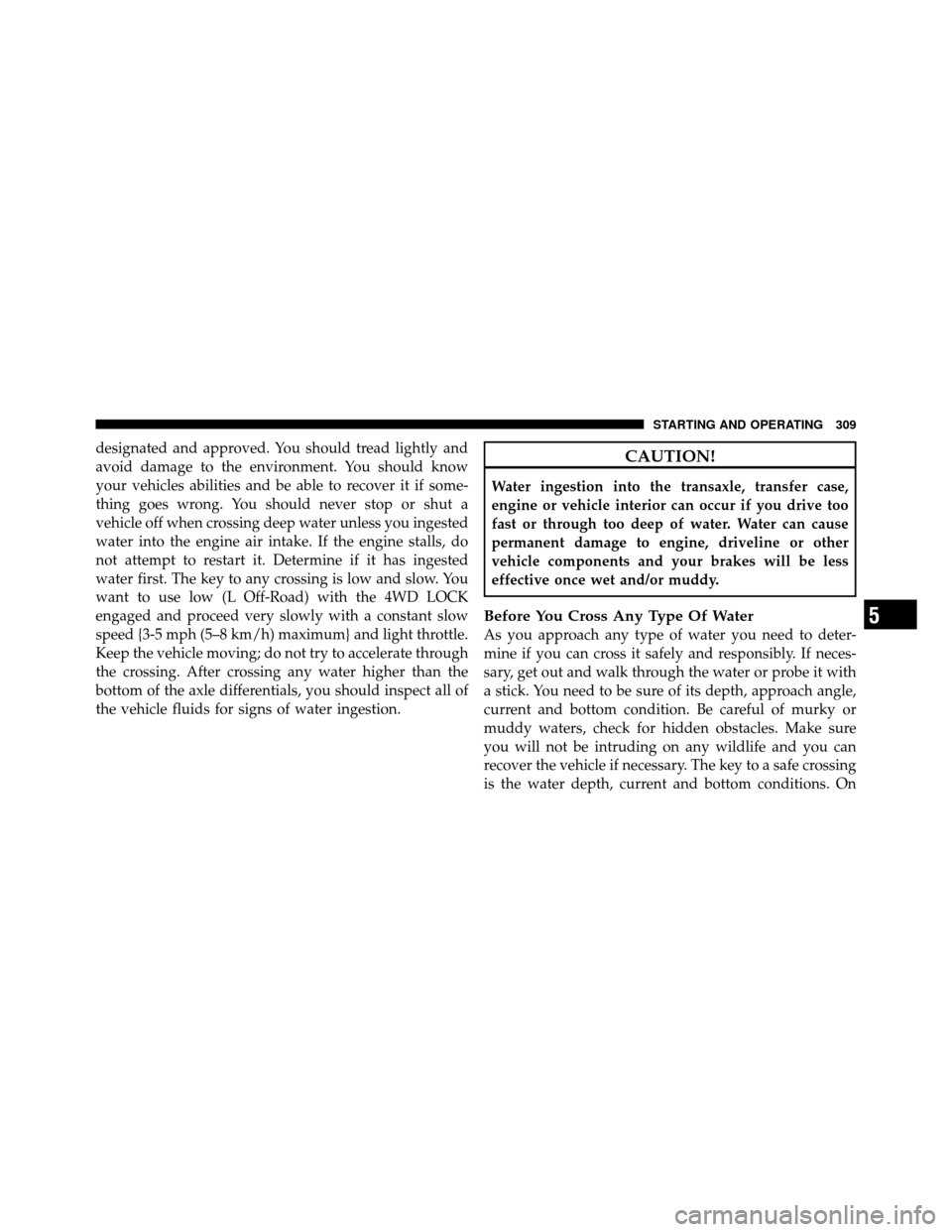Page 311 of 490

designated and approved. You should tread lightly and
avoid damage to the environment. You should know
your vehicles abilities and be able to recover it if some-
thing goes wrong. You should never stop or shut a
vehicle off when crossing deep water unless you ingested
water into the engine air intake. If the engine stalls, do
not attempt to restart it. Determine if it has ingested
water first. The key to any crossing is low and slow. You
want to use low (L Off-Road) with the 4WD LOCK
engaged and proceed very slowly with a constant slow
speed {3-5 mph (5–8 km/h) maximum} and light throttle.
Keep the vehicle moving; do not try to accelerate through
the crossing. After crossing any water higher than the
bottom of the axle differentials, you should inspect all of
the vehicle fluids for signs of water ingestion.CAUTION!
Water ingestion into the transaxle, transfer case,
engine or vehicle interior can occur if you drive too
fast or through too deep of water. Water can cause
permanent damage to engine, driveline or other
vehicle components and your brakes will be less
effective once wet and/or muddy.
Before You Cross Any Type Of Water
As you approach any type of water you need to deter-
mine if you can cross it safely and responsibly. If neces-
sary, get out and walk through the water or probe it with
a stick. You need to be sure of its depth, approach angle,
current and bottom condition. Be careful of murky or
muddy waters, check for hidden obstacles. Make sure
you will not be intruding on any wildlife and you can
recover the vehicle if necessary. The key to a safe crossing
is the water depth, current and bottom conditions. On
5
STARTING AND OPERATING 309
Page 322 of 490

WARNING!
•The Brake Assist System (BAS) cannot prevent the
natural laws of physics from acting on the vehicle,
nor can it increase the traction afforded by prevail-
ing road conditions.
•The BAS cannot prevent collisions, including
those resulting from excessive speed in turns,
driving on very slippery surfaces, or hydroplan-
ing.
•The capabilities of a BAS-equipped vehicle must
never be exploited in a reckless or dangerous
manner which could jeopardize the user ’s safety
or the safety of others.
Traction Control System (TCS)
This system monitors the amount of wheel spin of each of
the driven wheels. If wheel spin is detected, brake
pressure is applied to the slipping wheel(s) and engine
power is reduced to provide enhanced acceleration and
stability. A feature of the TCS system functions similar to
a limited slip differential and controls the wheel spin
across a driven axle. If one wheel on a driven axle is
spinning faster than the other, the system will apply the
brake of the spinning wheel. This will allow more engine
torque to be applied to the wheel that is not spinning.
This feature remains active even if TCS and ESC are in
either the “Partial Off” or “Full Off” modes. Refer to
“Electronic Stability Control (ESC)” in this section of this
manual.
320 STARTING AND OPERATING
Page 481 of 490

Pets.................................. 83
Phone, Cellular .......................... 98
Phone, Hands-Free (Uconnect™) .............. 98
Placard, Tire and Loading Information ......... 334
Power Door Locks ......................... 28
Mirrors ............................ 95
Outlet (Auxiliary Electrical Outlet) ........ 170
Steering ........................ 31 1,313
Sunroof ........................... 166
Transfer Unit ....................... 425
Windows ........................... 33
Power Steering Fluid ..................... 440
Power Transfer Unit ...................... 425
Pregnant Women and Seat Belts .............. 59
Preparation for Jacking .................... 383
Pretensioners Seat Belts ........................... 53
Programmable Electronic Features ............ 214Radial Ply Tires
......................... 341
Radio Operation ........................ 273
Rear Axle (Differential) .................... 425
Rear Drive Assembly ..................... 425
Rear Liftgate (Sedan) ...................... 35
Rear Seat, Folding ....................... 144
Rear Window Defroster ................... 185
Rear Window Features .................... 184
Rear Wiper/Washer ...................... 184
Recorder, Event Data ...................... 73
Recreational Towing ...................... 378
Reformulated Gasoline .................... 358
Refrigerant ............................ 411
Reminder, Seat Belt ....................... 57
Remote Control Door Locks ......................... 18
Security Alarm ....................... 17
Remote Keyless Entry (Sedan) ............... 18
Remote Sound System (Radio) Controls ........ 271
10
INDEX 479